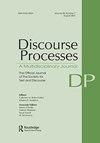德语和意大利语人称代词和指示代词解释中活力与句法功能的相互作用
IF 2.1
2区 心理学
Q2 PSYCHOLOGY, EDUCATIONAL
引用次数: 0
摘要
本文研究了动性与指称先行词的句法功能的相互作用如何决定了德语和意大利语中不同类型代词和指示语的解释。在两种语言中进行的句子接续任务的结果表明,意大利语的空代词和德语的p代词都有很强的指向前面主语的倾向,但前提是它的指称对象是有生命的。对于无生命的主语,这两种形式都倾向于引用处于客体位置的有生命的指称物,这表明有生命性比前面提到的句法功能更能增强指称物的可及性。德语和意大利语的指示词通常倾向于指代宾语先行词,这种倾向也受到指称物的活力的影响,尤其是在德语中。跨语言比较发现,德语的动画效果总体上强于意大利语,这表明在不同的语言中,不同的形式对句法功能和动画的敏感性可能不同。本文章由计算机程序翻译,如有差异,请以英文原文为准。
Pinning down the interaction between animacy and syntactic function in the interpretation of German and Italian personal and demonstrative pronouns
This article investigates how animacy in interaction with the syntactic function of a referent’s antecedent determines the interpretation of different types of pronouns and demonstratives in German and Italian. The results of a sentence continuation task conducted in both languages show that Italian null pronouns and German p-pronouns have a strong tendency to refer to a preceding subject, but only if its referent is animate. With inanimate subjects, both forms tend to refer to the animate referent in object position, showing that animacy enhances a referent’s accessibility more than the syntactic function of its previous mention. Demonstratives in German and Italian generally tend to refer to object antecedents, a tendency that is also influenced by the animacy of the referent, especially in German. The cross-linguistic comparison reveals that the effect of animacy is overall stronger in German than in Italian, suggesting that across languages, different forms may show a different sensitivity to syntactic function and animacy.
求助全文
通过发布文献求助,成功后即可免费获取论文全文。
去求助
来源期刊

Discourse Processes
Multiple-
CiteScore
4.30
自引率
4.50%
发文量
27
期刊介绍:
Discourse Processes is a multidisciplinary journal providing a forum for cross-fertilization of ideas from diverse disciplines sharing a common interest in discourse--prose comprehension and recall, dialogue analysis, text grammar construction, computer simulation of natural language, cross-cultural comparisons of communicative competence, or related topics. The problems posed by multisentence contexts and the methods required to investigate them, although not always unique to discourse, are sufficiently distinct so as to require an organized mode of scientific interaction made possible through the journal.
 求助内容:
求助内容: 应助结果提醒方式:
应助结果提醒方式:


